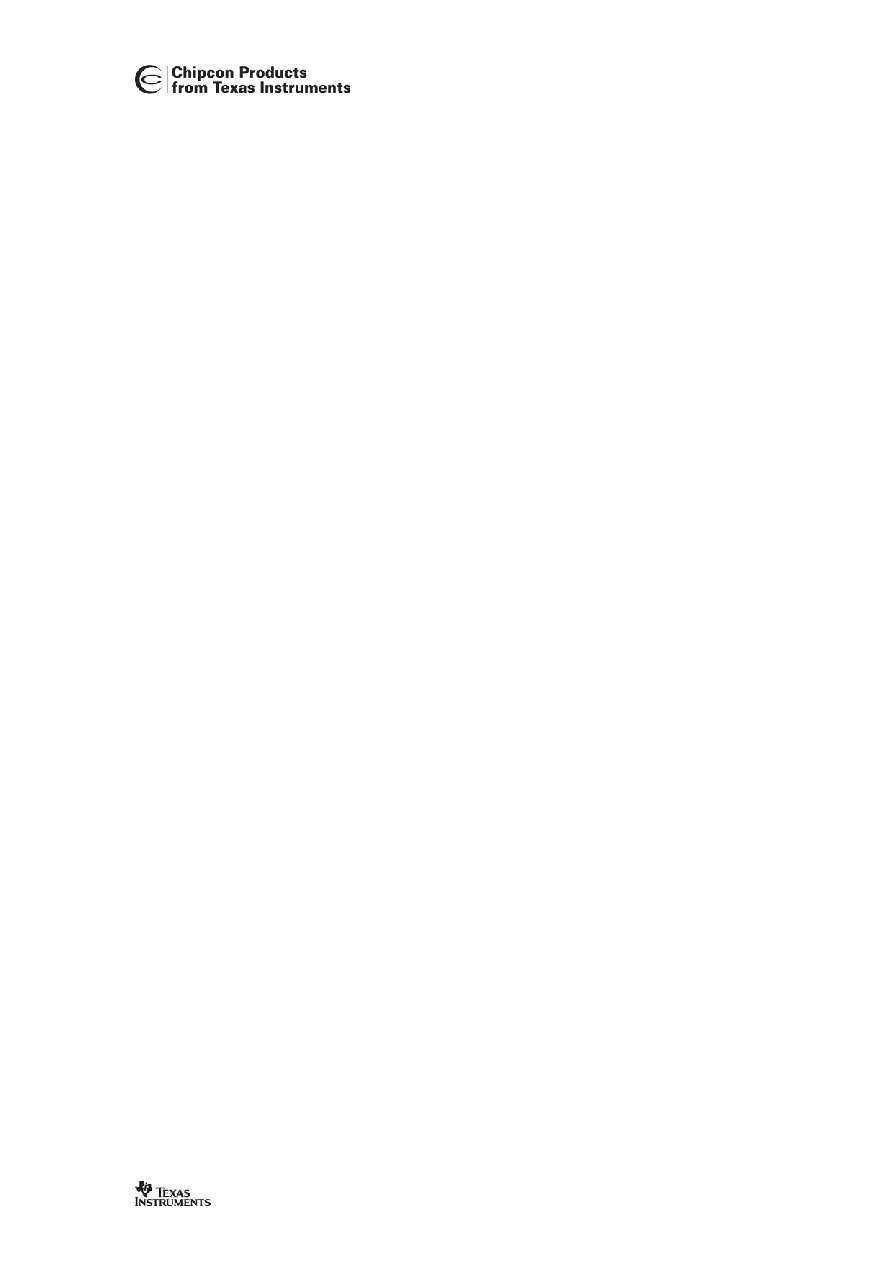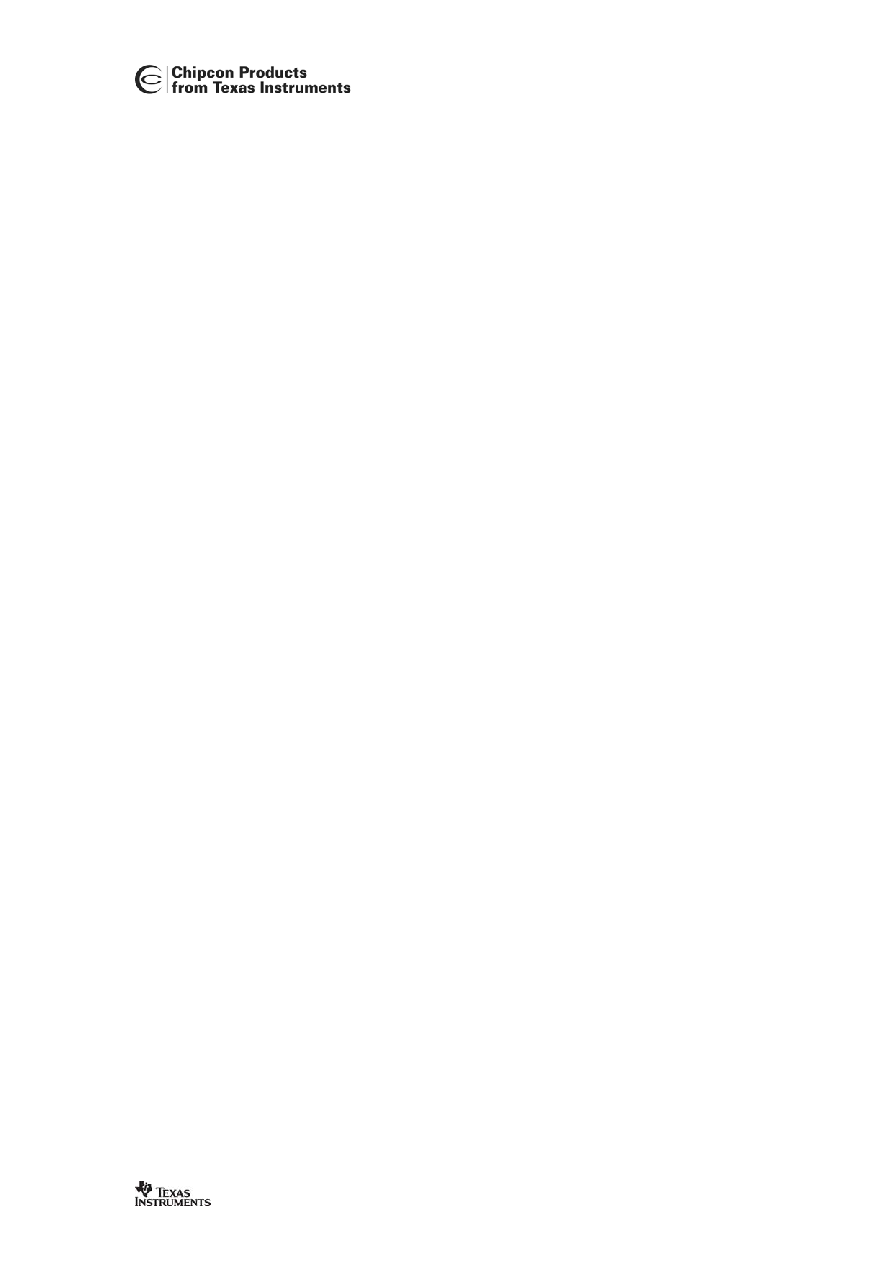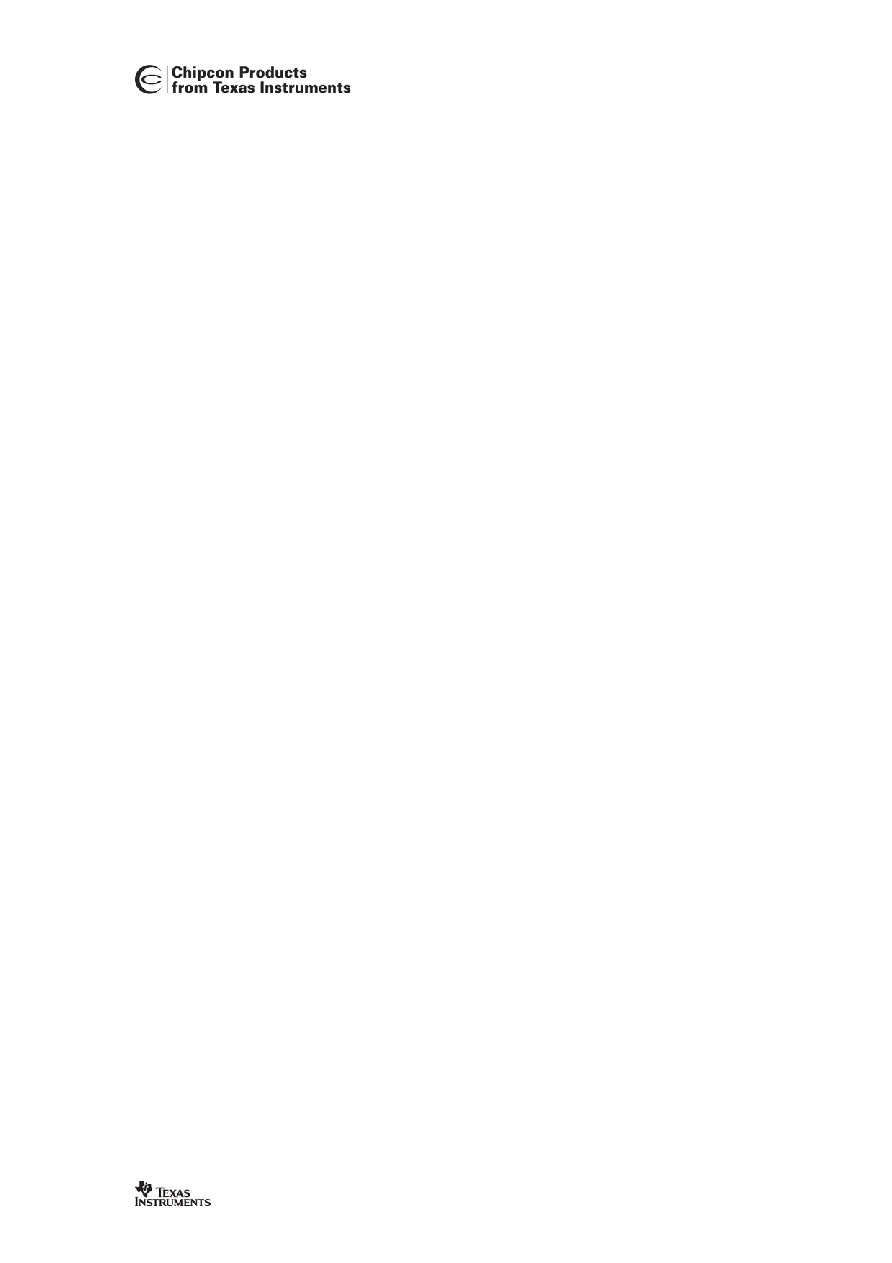
CC1020
SWRS046 Page 1 of 92
CC1020
Single Chip Low Power RF Transceiver for Narrowband Systems
Applications
∑ Narrowband low power UHF wireless
data transmitters and receivers with
channel spacings as low as 12.5 and
25 kHz
∑ 402 / 424 / 426 / 429 / 433 / 447 / 449 /
469 / 868 and 915 MHz ISM/SRD
band systems
∑ AMR ≠ Automatic Meter Reading
∑ Wireless alarm and security systems
∑ Home automation
∑ Low power telemetry
Product Description
CC1020 is a true single-chip UHF trans-
ceiver designed for very low power and
very low voltage wireless applications. The
circuit is mainly intended for the ISM
(Industrial, Scientific and Medical) and
SRD (Short Range Device) frequency
bands at 402, 424, 426, 429, 433, 447,
449, 469, 868 and 915 MHz, but can
easily be programmed for multi-channel
operation at other frequencies in the 402 -
470 and 804 - 940 MHz range.
The
CC1020 is especially suited for narrow-
band systems with channel spacings of
12.5 or 25 kHz complying with ARIB STD
T-67 and EN 300 220.
The
CC1020 main operating parameters
can be programmed via a serial bus, thus
making
CC1020 a very flexible and easy to
use transceiver.
In a typical system
CC1020 will be used
together with a microcontroller and a few
external passive components.
CC1020 is based on Chipcon's SmartRF
Æ
-
02 technology in 0.35
µm CMOS.
Features
∑ True single chip UHF RF transceiver
∑ Frequency range 402 MHz - 470 MHz
and 804 MHz - 940 MHz
∑ High sensitivity (up to ≠118 dBm for a
12.5 kHz channel)
∑ Programmable output power
∑ Low current consumption (RX: 19.9
mA)
∑ Low supply voltage (2.3 V to 3.6 V)
∑ No external IF filter needed
∑ Low-IF
receiver
∑ Very few external components required
∑ Small size (QFN 32 package)
∑ Pb-free
package
∑ Digital RSSI and carrier sense indicator
∑ Data rate up to 153.6 kBaud
∑ OOK, FSK and GFSK data modulation
∑ Integrated
bit
synchronizer
∑ Image rejection mixer
∑ Programmable frequency and AFC
make crystal temperature drift
compensation possible without TCXO
∑ Suitable for frequency hopping systems
∑
Suited for systems targeting
compliance with EN 300 220, FCC
CFR47 part 15 and ARIB STD T-67
∑ Development kit available
∑ Easy-to-use software for generating the
CC1020 configuration data

CC1020
SWRS046 Page 2 of 92
Table of Contents
1.
Abbreviations................................................................................................................ 4
2.
Absolute Maximum Ratings......................................................................................... 5
3.
Operating Conditions ................................................................................................... 5
4.
Electrical Specifications .............................................................................................. 5
4.1.
RF Transmit Section ............................................................................................ 6
4.2.
RF Receive Section ............................................................................................. 8
4.3.
RSSI / Carrier Sense Section ............................................................................ 11
4.4.
IF Section........................................................................................................... 11
4.5.
Crystal Oscillator Section................................................................................... 12
4.6.
Frequency Synthesizer Section ......................................................................... 13
4.7.
Digital Inputs / Outputs....................................................................................... 14
4.8.
Current Consumption......................................................................................... 15
5.
Pin Assignment........................................................................................................... 15
6.
Circuit Description...................................................................................................... 17
7.
Application Circuit...................................................................................................... 18
8.
Configuration Overview ............................................................................................. 21
8.1.
Configuration Software ...................................................................................... 21
9.
Microcontroller Interface............................................................................................ 22
9.1.
4-wire Serial Configuration Interface ................................................................. 23
9.2.
Signal Interface .................................................................................................. 25
10.
Data Rate Programming............................................................................................. 27
11.
Frequency Programming ........................................................................................... 28
11.1.
Dithering ......................................................................................................... 29
12.
Receiver ....................................................................................................................... 30
12.1.
IF Frequency .................................................................................................. 30
12.2.
Receiver Channel Filter Bandwidth................................................................ 30
12.3.
Demodulator, Bit Synchronizer and Data Decision........................................ 31
12.4.
Receiver Sensitivity versus Data Rate and Frequency Separation ............... 32
12.5.
RSSI ............................................................................................................... 33
12.6.
Image Rejection Calibration ........................................................................... 35
12.7.
Blocking and Selectivity ................................................................................. 36
12.8.
Linear IF Chain and AGC Settings................................................................. 37
12.9.
AGC Settling................................................................................................... 38
12.10.
Preamble Length and Sync Word .................................................................. 39
12.11.
Carrier Sense ................................................................................................. 39
12.12.
Automatic Power-up Sequencing................................................................... 40
12.13.
Automatic Frequency Control......................................................................... 41

CC1020
SWRS046 Page 3 of 92
12.14.
Digital FM ....................................................................................................... 42
13.
Transmitter .................................................................................................................. 43
13.1.
FSK Modulation Formats ............................................................................... 43
13.2.
Output Power Programming........................................................................... 45
13.3.
TX Data Latency............................................................................................. 46
13.4.
Reducing Spurious Emission and Modulation Bandwidth.............................. 46
14.
Input / Output Matching and Filtering....................................................................... 46
15.
Frequency Synthesizer .............................................................................................. 50
15.1.
VCO, Charge Pump and PLL Loop Filter....................................................... 50
15.2.
VCO and PLL Self-Calibration ....................................................................... 51
15.3.
PLL Turn-on Time versus Loop Filter Bandwidth........................................... 52
15.4.
PLL Lock Time versus Loop Filter Bandwidth................................................ 53
16.
VCO and LNA Current Control .................................................................................. 53
17.
Power Management .................................................................................................... 54
18.
On-Off Keying (OOK).................................................................................................. 57
19.
Crystal Oscillator ........................................................................................................ 58
20.
Built-in Test Pattern Generator ................................................................................. 59
21.
Interrupt on Pin DCLK ................................................................................................ 60
21.1.
Interrupt upon PLL Lock................................................................................. 60
21.2.
Interrupt upon Received Signal Carrier Sense .............................................. 60
22.
PA_EN and LNA_EN Digital Output Pins ................................................................. 61
22.1.
Interfacing an External LNA or PA ................................................................. 61
22.2.
General Purpose Output Control Pins............................................................ 61
22.3.
PA_EN and LNA_EN Pin Drive...................................................................... 61
23.
System Considerations and Guidelines................................................................... 62
24.
PCB Layout Recommendations ................................................................................ 64
25.
Antenna Considerations ............................................................................................ 65
26.
Configuration Registers............................................................................................. 65
26.1.
CC1020 Register Overview............................................................................ 66
27.
Package Description (QFN 32) .................................................................................. 86
27.1.
Package Marking............................................................................................ 87
27.2.
Recommended PCB Footprint for Package (QFN 32)................................... 88
27.3.
Package Thermal Properties.......................................................................... 88
27.4.
Soldering Information ..................................................................................... 88
27.5.
Plastic Tube Specification .............................................................................. 89
27.6.
Carrier Tape and Reel Specification .............................................................. 89
28.
Ordering Information.................................................................................................. 89
29.
General Information.................................................................................................... 90

CC1020
SWRS046 Page 4 of 92
30.
Address Information................................................................................................... 92
1. Abbreviations
ACP
Adjacent
Channel
Power
ACR
Adjacent
Channel
Rejection
ADC
Analog-to-Digital
Converter
AFC
Automatic
Frequency
Control
AGC
Automatic
Gain
Control
AMR
Automatic
Meter
Reading
ASK
Amplitude
Shift
Keying
BER
Bit
Error
Rate
BOM
Bill
Of
Materials
bps
bits
per
second
BT
Bandwidth-Time product (for GFSK)
ChBW
Receiver Channel Filter Bandwidth
CW
Continuous
Wave
DAC
Digital-to-Analog
Converter
DNM
Do
Not
Mount
ESR
Equivalent
Series
Resistance
FHSS
Frequency
Hopping
Spread
Spectrum
FM
Frequency
Modulation
FS
Frequency
Synthesizer
FSK
Frequency
Shift
Keying
GFSK
Gaussian Frequency Shift Keying
IC
Integrated
Circuit
IF
Intermediate
Frequency
IP3
Third Order Intercept Point
ISM
Industrial
Scientific
Medical
kbps
kilo bits per second
LNA
Low
Noise
Amplifier
LO
Local Oscillator (in receive mode)
MCU
Micro
Controller
Unit
NRZ
Non Return to Zero
OOK
On-Off
Keying
PA
Power
Amplifier
PD
Phase Detector / Power Down
PER
Packet
Error
Rate
PCB
Printed
Circuit
Board
PN9
Pseudo-random Bit Sequence (9-bit)
PLL
Phase
Locked
Loop
PSEL
Program
Select
RF
Radio
Frequency
RSSI
Received Signal Strength Indicator
RX
Receive
(mode)
SBW
Signal
Bandwidth
SPI
Serial
Peripheral
Interface
SRD
Short
Range
Device
TBD
To
Be
Decided/Defined
T/R
Transmit/Receive
(switch)
TX
Transmit
(mode)
UHF
Ultra
High
Frequency
VCO
Voltage
Controlled
Oscillator
VGA
Variable
Gain
Amplifier
XOSC
Crystal
oscillator
XTAL
Crystal

CC1020
SWRS046 Page 5 of 92
2. Absolute
Maximum
Ratings
The absolute maximum ratings given Table 1 should under no circumstances be violated.
Stress exceeding one or more of the limiting values may cause permanent damage to the
device.
Parameter
Min
Max
Unit
Condition
Supply voltage, VDD
-0.3
5.0
V
All supply pins must have the
same voltage
Voltage on any pin
-0.3
VDD+0.3, max 5.0
V
Input RF level
10
dBm
Storage temperature range
-50
150
∞C
Package body temperature
260
∞C
Norm: IPC/JEDEC J-STD-020C
1
Humidity non-condensing
5
85
%
ESD
(Human Body Model)
±1
±0.4
kV
kV
All pads except RF
RF Pads
Table 1. Absolute maximum ratings
1
The reflow peak soldering temperature (body temperature) is specified according to
IPC/JEDEC J-STD_020C "Moisture/Reflow Sensitivity Classification for Nonhermetic Solid
State Surface Mount Devices".
Caution!
ESD sensitive device.
Precaution should be used when handling
the device in order to prevent permanent
damage.
3. Operating
Conditions
The operating conditions for
CC1020 are listed in Table 2.
Parameter
Min
Typ
Max
Unit
Condition / Note
RF Frequency Range
402
804
470
940
MHz
MHz
Programmable in <300 Hz steps
Programmable in <600 Hz steps
Operating ambient temperature
range
-40 85
∞C
Supply voltage
2.3 3.0 3.6 V
The same supply voltage should
be used for digital (DVDD) and
analog (AVDD) power.
A 3.0 ±0.1 V supply is
recommended to meet the ARIB
STD T-67 selectivity and output
power tolerance requirements.
Table 2. Operating conditions
4. Electrical
Specifications
Table 3 to Table 10 gives the
CC1020 electrical specifications.
All measurements were
performed using the 2 layer PCB CC1020EMX reference design. This is the same test circuit
as shown in Figure 3. Temperature = 25
∞C, supply voltage = AVDD = DVDD = 3.0 V if
nothing else stated. Crystal frequency = 14.7456 MHz.
The electrical specifications given for 868 MHz are also applicable for the 902 ≠ 928 MHz
frequency range.




